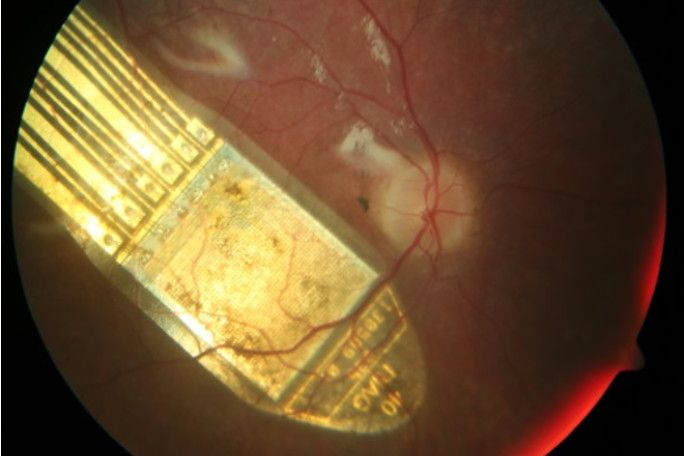| Duration: | 04/2018 - 03/2021 |
| Contracting Authority/ Sponsors: | Federal Ministry of Education and Research (BMBF) |
| Project Partners: | Retina Implant AG, Reutlingen (Verbundkoordinator); AZUR SPACE Solar Power GmbH, Heilbronn; MRI-StaR GmbH, Gelsenkirchen |
| Website: | https://www.elektronikforschung.de/projekte/lightbridge |
| Project Focus: |
LightBridge – Electronic System for the Wireless Power Supply of a Subretinal Micro Implant
With retinal implants, people who go blind from degenerative retinal diseases can regain their vision to a certain extent. The joint project "LightBridge" is developing an optical transmission path for supplying energy to the electronic micro implants, which transmits infrared light to the implant in the eye. Therefore, the consortium develops highly efficient photovoltaic cells and combines them with semiconductor-based light sources and microelectronic circuits embedded in flexible carrier films. In addition to optical power transmission, questions concerning biocompatibility, long-term functionality and MRI safety of the implant are dealt with.
Motivation
Microelectronics, as a key technology, forms the basis for numerous innovations in the field of intelligent medical technology. Medical use places special demands on the electronic system, for example with regard to biocompatibility, reliability, energy consumption and integrability. In addition, a variety of heterogeneous components must be combined, including sensor and actuator assemblies as well as components for signal processing, communication and energy generation. As a result, the technological basis for improved patient care is created.
Goals and Approach
For blind people, a retinal implant in the form of a microchip can be surgically inserted. For the energy supply of the electronic implant, a cable must be routed through the sclera, the surface of the eye. This is surgically complex and can lead to tissue irritation. The aim of the project is to develop powerful and reliable electronics for wireless power supply and control of the retinal implants. This works by means of light pulses transmitted from outside the eye. For this "light bridge", integrated microelectronic circuits, semiconductor-based light sources and highly efficient photovoltaic cells are combined and embedded in flexible carrier films. The new technique also promises to improve the compatibility of the implant with MRI examinations.
Innovations and Perspectives
The wireless control and energy supply of implants promises a higher quality of life for affected patients. The concept of the light bridge goes far beyond the current state of the art. This opens up many possibilities for expanding the range of technology applications in medical technology.
